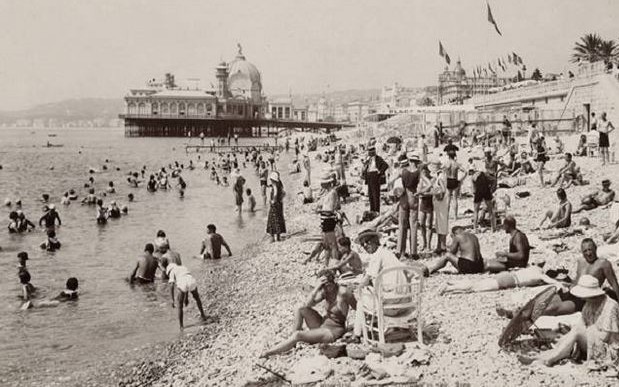Exhibition Nice of Annees Folles
Exhibition from the collections of the Museum of the photography Charles Negro, with the original prints of Gabriele Basilico, Michel Coen, Jean Gilletta and Joseph Lucarelli.
Photographs of Paul Louis is from the Fund Norbert Huffschmitt.
At the end of the XIXe century, Nice became the world capital of winter tourism, but the outbreak of the first world war in August 1914 just seriously affect the local economy. Tourism, hospitality, construction, floral culture, are in big trouble and unemployment continues to rise. The announcement of the Armistice on 11 November 1918, just put an end to those dark years. As early as 1919, the rich winterers find their way to Nice. Only the Russians are missing and if they find the idelly shorelines, it is often ruined. The English remain the most numerous, but the Americans came en masse to invest, which will mark the Annees Folles by their extravagances.
A movement of euphoria and release then invades the country. The French are rediscovering the pleasure of having fun and all of society finds an interest in culture. The 1920s become synonymous of a bubbling with an effervescence, that will be at the origin of the "Années Folles" qualifier With foreign capital, and particularly Americans, the economy recovers. A radically new wind seems to blow on the country. If Paris is the epicenter of this happy and festive stirring, Nice is no exception to this new dynamic that is revolutionizing the Middle cultural and intellectual pre-war.
For vacationers, the sea baths is no longer in effect. We organize new hobbies with dedicated infrastructure: car races, bicycle races, horse racing, shooting, racing, tennis clubs... Many sports events punctuate the life of the people of Nice: Nice motorcyclist, the Paris-Nice cycling race and the Paris-Nice car, the Grand prix... The casinos and theatres offer many shows and galas with to display stars in vogue of the Annees Folles: Maurice Chevalier, Joséphine Baker...
Balls and Carnival processions brighten the winter season. In parallel with these festivals are growing more elegant, more aristocratic parties and worldly as the vegliones and the redoubts who will leave Street for places closed such as Opera, the municipal Casino, the Palace of the Mediterranean or the private and artistic circles. The Ruhl to entertain its customers high-end hotel hosts wild parties of art in a wondrous splendour that excessiveness has permanently marked the history of Nice.
Urbanism and architecture of the city will be marked by the new fashion of sea bathing, the introduction of paid in 1936 and the summer holidays. The city population doubles almost between 1914 and 1939 with the installation in particular of many pensioners and retirees. In the city center, many villas are replaced by report buildings that rise as the former rural areas. Great axes are built or opened in an extension of the ancients as the boulevards of Cessole or Saint-Roch. The most spectacular is the reshaping of the Promenade des Anglais, with its two roadways separated part and another of a median, decorated with trees and plants.
After the war, we continue to build in the style in vogue in the Belle Epoque, of which the best example is the Ruhl. But the international exhibition of Decorative Arts and modern industry of Paris in 1925 will revolutionize architecture. The Art Nouveau in the Belle Epoque style follows the style Art Deco of Annees Folles. It is the almost perfect flurry of intellectual and artistic ideology that is approached in the development of a style where the modern combines with the classic with grace and elegance. The main features of the Art Deco style are simplicity of volumes, counting and the purity of the setting where now the straight line is omnipresent. The reinforced concrete and new construction techniques will promote this style more geometric that often come dressed high and low reliefs, carved decorations or in mosaic and stained glass. Nice has one of the most beautiful heritage Art deco France.
The Church of Jeanne d'Arc, our Lady help of Christians, the Forum, the Gloria Mansions, the Mediterranean Palace, post Thiers and the monument to the dead to Rauba Capèu belong to different currents of the Art Deco style that characterize the new nice landscape. It's all a new aesthetic that is needed.
The page was then quickly filmed after the first world war. Worn by men who want to invent another world, Nice becomes a land of experimentation and modernism.

Photo caption: Jean Gilletta, the beach, bathers - Nice 1930

 StayHostel, ...
StayHostel, ... VisitMuseums, ...
VisitMuseums, ... Go outRestaurants, ...
Go outRestaurants, ... ShopsFashion, ...
ShopsFashion, ... LeisuresBeaches, sports, ...
LeisuresBeaches, sports, ... ServicesTourism, ...
ServicesTourism, ...






